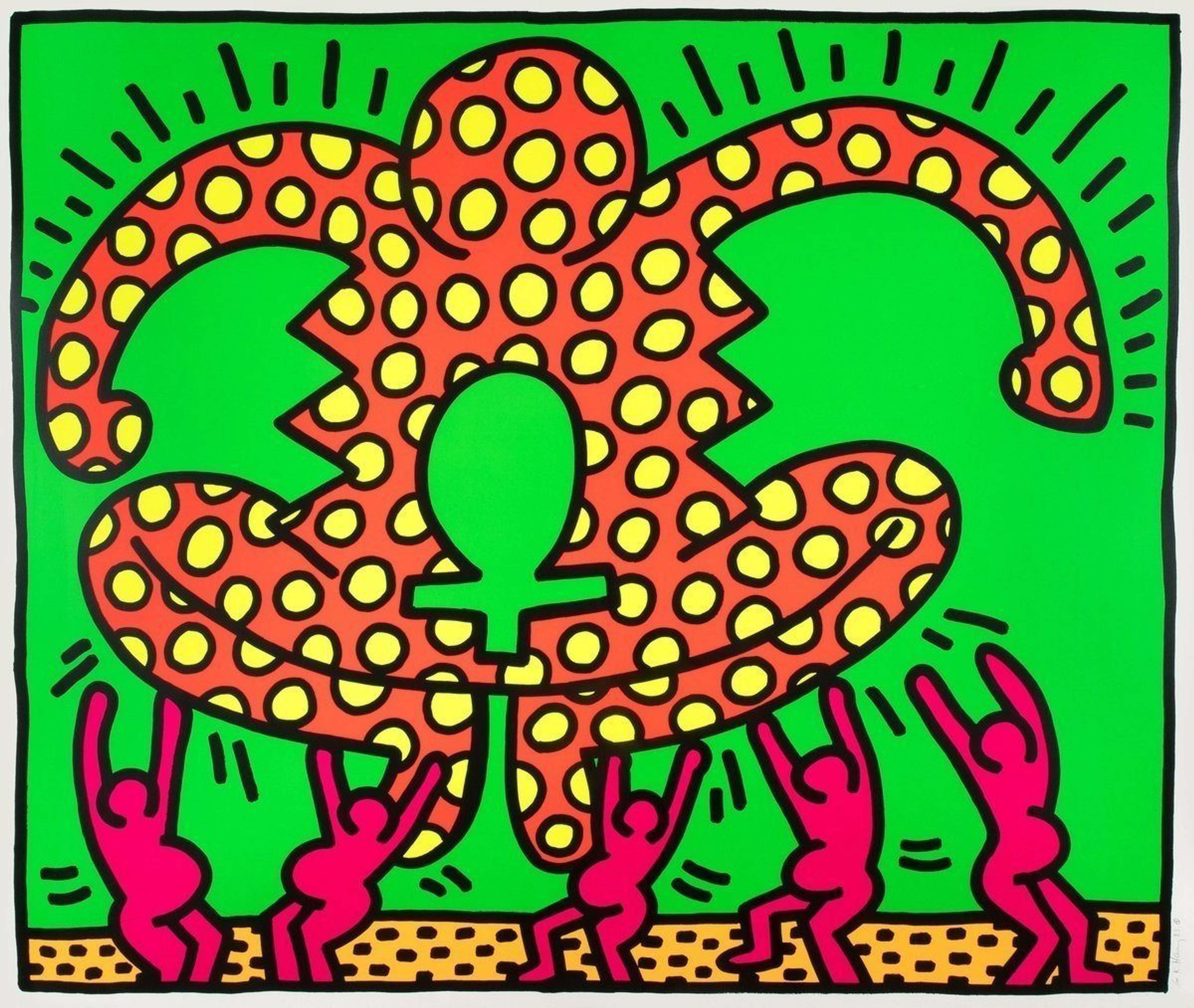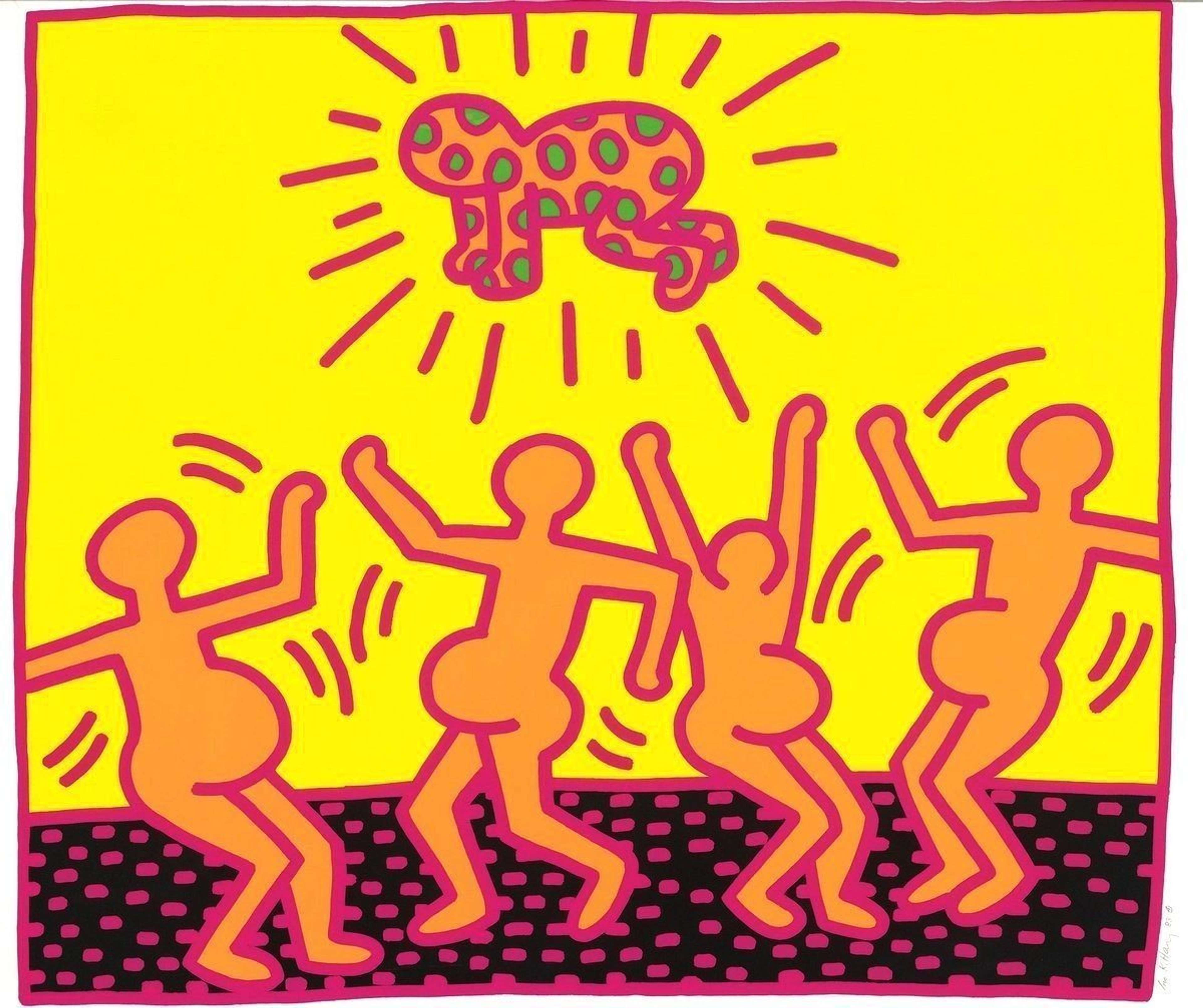 Fertility 5 © Keith Haring 1983
Fertility 5 © Keith Haring 1983
Interested in buying or selling
Keith Haring?

Keith Haring
250 works
Keith Haring's Fertility Suite spotlights the global travesty of the HIV/AIDS epidemic with typical visual rigour. With bold colour and provoking symbolism, Fertility Suite stressed the impact of the disease on Sub-Saharan African women.
The portfolio was created to raise awareness and criticise the prevalence of HIV/AIDS among pregnant women in Sub-Saharan Africa.
 Fertility 3 © Keith Haring 1983
Fertility 3 © Keith Haring 1983Created in 1983, in the midst of the global HIV/AIDS epidemic, Haring created his Fertility Suite portfolio to highlight the wide-reaching devastation of the disease. The epidemic had a particularly catastrophic effect on pregnant women in Sub-Saharan Africa, and Haring used his portfolio to spotlight this overlooked demographic. Particularly in Fertility 3, Haring represents a pregnant figure collapsing, being propped up by the infantile figures about her.
Haring appropriates Ancient Egyptian symbols to connote feminine energy.
 Fertility 5 © Keith Haring 1983
Fertility 5 © Keith Haring 1983At the centre of some of his figures, as in Fertility 5, Haring outlined an Ancient Egyptian 'Ankh' symbol. The symbol, representative of eternal life, was used in this series to convey the womb as the literal key to life, despite being the key to death for many women during the HIV/AIDS epidemic. Likewise, the large figure at the centre of this work (and Fertility 4) is reminiscent of the Ancient Egyptian 'Tyet'. Connected to the goddess Isis, this symbol represents the renewal of life, and was perhaps used by Haring as an optimistic plea to end the epidemic once and for all.
Haring's iconography suggests the inevitability of suffering for pregnant women during the HIV/AIDS epidemic.
 Fertility 4 © Keith Haring 1983
Fertility 4 © Keith Haring 1983By representing these pregnant, womanly bodies in the clutches of a womb-like figure, Haring shows these women to be at the mercy of the merciless disease sweeping the globe in 1983. Despite childbearing being a natural part of the circle of life, Haring conveys the dangers of reproduction in the midst of HIV/AIDS.
The series uses Haring's iconic Radiant Baby as one of its central motifs.
 Radiant Baby © Keith Haring 1990
Radiant Baby © Keith Haring 1990Radiant Baby is one of Haring's most iconic and repeated motifs. Haring once described his original Radiant Baby as "The purest and most positive experience in human existence". However, in his Fertility Suite the Radiant Baby is subverted, showing how the conception of children could prove fatal.
Haring looks to Ancient Egyptian motifs to suggest the 'othering' of people suffering from HIV/AIDS.
 Fertility 2 © Keith Haring 1983
Fertility 2 © Keith Haring 1983In Fertility Suite, Haring uses the pyramid as a visual symbol, confronting the 'othering' of certain groups in society. Much like his Pyramids, this portfolio critiques the alienation of people affected by the HIV/AIDS epidemic, and urges viewers to acknowledge the global injustice inflicted by the disease.
Haring's UFOs emerge as a positive force in Fertility Suite.
 The Blueprint Drawings 2 © Keith Haring 1990
The Blueprint Drawings 2 © Keith Haring 1990Though Haring was famously wary of technology, UFOs became a commonplace motif in his work and symbolised positive forces of change. As Haring once said of his UFOs: "The saucers were zapping things with an energy ray, which would then endow whatever it zapped with its power". As in The Blueprint Drawings 2, the UFOs in Fertility Suite seem to possess a restorative power, symbolising salvation from the disease.
The patterns in Fertility Suite have a macabre undertone.
 Fertility 1 © Keith Haring 1983
Fertility 1 © Keith Haring 1983Contrary to Haring's typical use of block colours to fill in his iconic figures, his Fertility Suite is marked by colourful dots and dashes. These patterns have been interpreted as lesions, much like those of people living with HIV/AIDS. As we see in Fertility 1, these patterns overwhelm the otherwise simple compositions, and allude to the grim symptoms of the disease.
Haring uses neon colour to spotlight the pressing global issue of HIV/AIDS.
 Art Attack On Aids (yellow) © Keith Haring 1988
Art Attack On Aids (yellow) © Keith Haring 1988Throughout his oeuvre, Haring frequently used bright and eye-catching colour to highlight socio-political issues with a lighthearted aesthetic. Fertility Suite is underscored by Haring's daring use of neons, making the issue of HIV/AIDS unavoidable in the work. This is something Haring implemented progressively throughout his career, especially after his own diagnosis with AIDS in 1988.
Fertility Suite is testament to Haring's creation of a universally understandable iconography.
 Pop Shop I, Plate I © Keith Haring 1987
Pop Shop I, Plate I © Keith Haring 1987Haring committed his life and career to producing an iconography which could be understood by all. His iconic figures and characters, which are repeated across his entire body of work, have been considered 'modern hieroglyphics'. In their naive simplicity, Haring's figures can be interpreted by all viewers, regardless of sexual, gender, class, and language barriers.
The portfolio is a vivid example of Haring's use of relatable characters to convey prevailing socio-political issues.
 Silence Equals Death © Keith Haring 1989
Silence Equals Death © Keith Haring 1989Although Haring's use of bright colour and naive figures gives his works a joyous visual appeal, they allude to some of the most serious socio-political issues of his age. Much like his defining work Silence Equals Death, Fertility Suite represents the global travesty of the HIV/AIDS epidemic with visual rigour. Haring therefore not only critiqued the US government's ignorant approach to the disease, but underlined it as the most pressing global issue of the 1980s.
